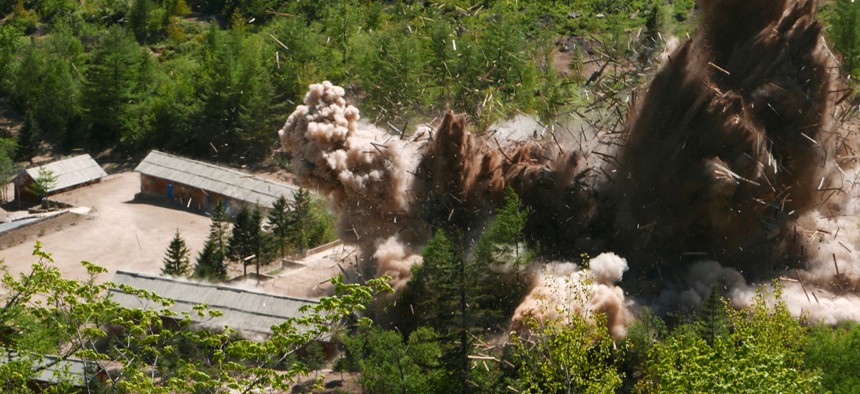
Smoke and debris rise in the air as barracks buildings for guards and tunneling workers at North Korea's nuclear test site are blown up at Punggye-ri, North Hamgyong Province, North Korea, on May 24, 2018. APTN via AP
How to Bring the US-NK Rollercoaster Back to Earth
It starts with a sober assessment of what’s possible. Not on that list: Pyongyang somehow forgetting how to make nukes.
After a decade of despair and neglect, experts on North Korea’s nuclear weapons are thrilled and terrified at the prospect of all that could go right or wrong in negotiations with that secluded state. In the last month alone, nuclear diplomacy with North Korea has reached giddy heights and dismaying lows, and the rollercoaster ride is only just beginning. In just the last week, Mr. Kim blew up his nuclear test site just as Mr. Trump was blowing up the June summit with a letter that cancelled it, but left the door open wistfully. Within hours, Vice Foreign Minister Kim Kye Gwan’s conciliatory message earned an appreciative tweet by President Trump. Maybe things could still work out for a June 12 summit.
Rollercoaster rides can be exhilarating but also exhausting for those who underestimate their own stamina or the severity of the twists and turns. Or for those who aren’t quite strapped in. The sources of the recent flare-up are statements by U.S. National Security Advisor John Bolton in late April and by Vice President Pence in late May about how nuclear disarmament would proceed. Bolton suggested a Libya-like scenario could unfold, wherein North Korea would send the offending equipment to the United States for a post-mortem. Pence suggested on FOX News that if North Korea did not completely disarm, Kim could suffer a fate similar to that of Libyan leader Moammar Qaddafi, the target of NATO bombing campaigns that led to his capture and death by torture at the hands of his own people.
It’s no accident that the North Koreans chose to describe Bolton and Pence as “unbridled,” repeating that word in several official statements. They see those two officials as less committed to the process than President Trump and Secretary Pompeo. But there’s another reason why the North Koreans consider Pence and Bolton to be unbridled — it’s because their policies and assumptions are untethered from reality.
Let’s take Libya first. For many reasons, North Korea isn’t Libya. It has real nuclear warheads, possibly 40 to 60; and real intercontinental range ballistic missiles. It has both plutonium production facilities and uranium enrichment facilities, and probably more than one. North Korea also likely has active biological and chemical weapons programs. When Moammar Qaddafi decided to give up his nuclear program, his centrifuges were still packed in crates, unassembled. Avoiding the Libyan leader’s fate is the reason why Kim Jong Un has insisted not on economic assistance (the kind consistently emphasized by President Trump) but, instead, on lasting security measures. The cost may be higher than United States is prepared to pay, but a peace treaty is a downpayment.
The other area in which Trump’s emerging policy on North Korea is unmoored from reality is the insistence on comprehensive, verified, irreversible dismantlement. This Bush-era concept was always more aspirational than operational. The single supposedly irreversible dismantlement was the 2008 destruction of the cooling tower for the Yongbyon reactor. And yet this failed to keep the North Koreans from running the reactor and producing more plutonium for weapons in the wake of the collapse of the Six Party Talks.
Today, a larger, sophisticated North Korean nuclear weapons arsenal renders the concept of irreversible dismantlement irrelevant. Negotiators should strive for the most comprehensive agreement possible and for the most effective verification. But North Koreans won’t forget how to construct nuclear weapons and it is useless to ignore this fact in a misguided effort to place them in the pantheon of failed states like Libya and Iraq.
The model of South Africa, which dismantled its nuclear weapons and then joined the Nuclear Nonproliferation Treaty in 1990 as a non-nuclear weapon state, may be a closer fit with North Korea than Libya or Iraq, but that model also has problems. South Africa took apart its weapons and some facilities, and destroyed bomb designs before inviting inspectors to verify dismantlement. Domestic security concerns, rather than the need to provide international credibility to gain security assurances, shaped South Africa’s secrecy. Such a process obviously wouldn’t work for either North Korea or the United States, even though it could be quicker. Still, the administration has been relatively silent so far on the unilateral destruction of North Korea’s nuclear test site at Punggye-ri.
But a bigger problem with the South Africa model is that South Africa never had ballistic missiles that threatened the United States. This glaring problem has led some experts to wonder whether Trump might be willing to settle for an agreement just to eliminate intercontinental range missiles. While perhaps attractive to the “America First” crowd, such an approach could be a disaster, leaving North Korea’s nuclear weapons in place to threaten U.S. allies Japan and South Korea. If part of a phased approach, limits on ballistic missiles must surely be within the scope of a comprehensive agreement, but the notion that North Korea would relinquish its greatest asset first is unrealistic. If negotiations are in fact restarted, all the stakeholders of greater stability and security in Northeast Asia will need to temper their desire for political thrills with a sober assessment of what is possible.




